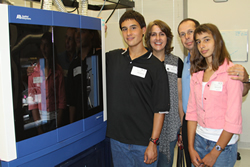Last updated: February 10, 2014
Transforming clinical care with whole genome sequencing
Genome Advance of the Month
Transforming clinical care with whole genome sequencing
June 2011
Jonathan Gitlin, Ph.D., Science Policy Analyst
and Larry Thompson, M.S., M.F.A., Communications Director
 |
The cases are arriving in ones and twos, cases where sequencing the whole genome of a sick person results in discoveries that change medical care. Rare diseases comprise the current successes; but it won't be long before the plummeting cost of sequencing, and powerful new analytical techniques, will transform the care of common illnesses, too.
For example, the 2011 Pulitzer Prize for Explanatory Reporting went to reporters at the Milwaukee Journal Sentinel for describing a strange case of extreme irritable bowel syndrome threatening the life of a 4-year-old boy, and how whole genome sequencing identified the underlying mutation, changed his treatment and probably saved his life.
In the February issue of The New England Journal of Medicine, researchers described the discovery of a new disease in a Kentucky family by scientists at the NIH Undiagnosed Disease Program, who also used whole-genome analysis and targeted sequencing.
Now, the June issue of Science Translational Medicine reports on fraternal twins from California, a brother and sister, suffering not one but two inherited mutations that threatened to impede or even prematurely end their lives. Whole genome sequencing at the Human Genome Sequencing Center at Baylor College of Medicine, Tex., one of three facilities that comprise the National Human Genome Research Institute's (NHGRI) large-scale genome sequencing program, led to the discovery and is selected as June's Genome Advance of the Month.
In this now widely reported case, doctors initially diagnosed Alexis and Noah Beery of Encinitas, Calif., at age 2 with cerebral palsy. But their mother, Retta Beery, felt her children's symptoms did not matched the diagnosis and her persistent research led doctors to a new diagnosis by the time her children were 5 years old: dopa-responsive dystonia or DRD, a rare condition that causes muscles to spasm and twist, but responds to treatment with low doses of L-dopa, the same drug used to treat Parkinson's disease.
Just as with Parkinson's, however, L-dopa treatment eventually became less effective and the strange symptoms returned, including hand tremors, awkwardness and attention problems for Noah. and increasingly serious breathing problems for Alexis caused by larynx spasms.
Tests for mutations in three known genes associated with DRD proved insufficient. Mutations in the genes encoding guanosine 5-triphosphate (GTP) cyclohydrolase and tyrosine hydroxylase were ruled out, but the absence of a clinical test for sepiapterin reductase (SPR), the third candidate, led the twins' clinical team to consider whole genome sequencing to pinpoint the cause of their disease.
Joe Beery, the twins' father, works for a biotech company that makes DNA sequencing machines. Mr. Beery approached the Baylor team, including sequencing center director Richard Gibbs, Ph.D., and James R. Lupski, M.D., Ph.D., Baylor's vice chairman of genetics. Dr. Lupski had been diagnosed with Charcot-Marie-Tooth syndrome, a disorder of peripheral nerves in the limbs, hands and feet, when he was 15 years old. But the genetic cause of his particular disorder remained unknown until his own genome was sequenced, pinpointing the mutation among the almost 40 genes known to be associated with the condition, as reported last year in The New England Journal of Medicine.
The Baylor team sequenced the whole genomes of the twins, their parents and an unaffected sibling - five whole genomes in all for a total of nearly 180 billion base pairs. Having high quality genomic data from such closely related individuals meant that the researchers were looking for gene mutations present in both twins, but lacking in their parents and their unaffected sibling. While that may sound like a simple matter of subtraction, the computational effort was anything but routine.
Analyzing the five genomes revealed that the twins had a pair of mutations in sepiapterin reductase (SPR), one from each parent. Their mother carries a nonsense mutation that produces a truncated protein that does not work, and their father carries a missense mutation that substitutes an amino acid in the final protein, changing the way it works.
Since SPR is involved in the synthesis pathways for the neurotransmitters dopamine and serotonin, simply replacing dopamine with L-dopa when they were 5 years old was not enough to manage the symptoms. Their doctors needed to boost serotonin, as well. This suggested that supplementing the twins' L-dopa treatment (which boosts dopamine) with 5-hydroxytryptophan (which boosts serotonin) might have clinical benefit. And the clinical predictions proved correct: Within a week or two after adding 5-hydroxytryptophan, both twins reported increased focus at school and improved coordination and movement. Alexis began competing in sports again, which the breathing problems had prevented.
The costs of sequencing an entire human genome have fallen drastically, although are not yet cheap enough to form part of routine clinical care. Baylor reported that sequencing the whole genome of five individuals cost on the order of $30,000; but the computational analysis still requires interpretation by genome experts and sophisticated software at a cost of another $40,000. While whole genome sequencing may not be cost effective for general care, it is clearly moving in the right direction and will soon be in the toolkits of physicians and researchers for use in cases where diagnosis remains elusive.
Whole-Genome Sequencing for Optimized Patient Management. Sci. Trans. Med., June 15, 2011. [PubMed]
To view the PDF document(s) on this page, you will need Adobe Reader. ![]()
Last Updated: February 10, 2014
